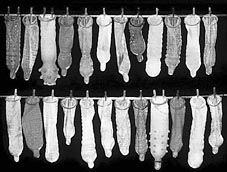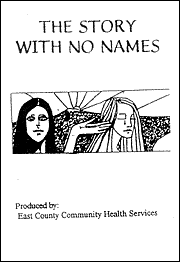|
|
Innovative tools
  Responding to the varied HIV prevention needs in a
community using varied programs is challenging to do and even more challenging to
document. Service agencies can often have different means for measuring what’s
happening with their clients or programs than do funders or researchers.
|
 |
|
|
 Michelle teaches a
sexuality education program to girls in detention, rehab, probation and alternative
schools. “I think that monitoring behavior change with self observation is the best
way to (measure success). I can talk to an individual in my class one day and she may be
down and talking about ‘well, my boyfriend wants me to get pregnant and I don’t
want to get pregnant.’ And I might see her three months from now and I’ll say,
so what are you doing? ‘I’m going to school.’ Well, where’s your
boyfriend? ‘We’re still kicking it but you know, he’s doing his thing and
I’m doing my thing.’ What about the baby? ‘I don’t have time for a
baby.’ Basically, just dialoging with them and seeing them change from the person
that I remember to the person they’ve become.” Michelle teaches a
sexuality education program to girls in detention, rehab, probation and alternative
schools. “I think that monitoring behavior change with self observation is the best
way to (measure success). I can talk to an individual in my class one day and she may be
down and talking about ‘well, my boyfriend wants me to get pregnant and I don’t
want to get pregnant.’ And I might see her three months from now and I’ll say,
so what are you doing? ‘I’m going to school.’ Well, where’s your
boyfriend? ‘We’re still kicking it but you know, he’s doing his thing and
I’m doing my thing.’ What about the baby? ‘I don’t have time for a
baby.’ Basically, just dialoging with them and seeing them change from the person
that I remember to the person they’ve become.” |
|
A lot of these measures
of success are just stories, just one person’s tale of behavior change. And
that’s not enough to convince a funder that a program is effective, right? Well,
maybe it can be. Many agencies are starting to take these “stories” and put them
into a form that can tell the story to a larger audience. Comic books, ‘zines and
booklets are popular.
|
 |
|
|
 Lee, also known as
“Dr. Sex,” conducts custom condom consultations in sex clubs. “For us, our
major success is repeat contacts. At our custom condom consultations we actually sit down
and talk to a person about their sexual practices, what they do, what they don’t do.
Then we ask, for the men, about penis size, rough sex, the types of condoms they like to
use. Based on that, we carry an outreach kit that carries about 60 different condoms, and
we sit there and we put together a prescription package tailored to their needs. And
I’ll say field test them, then come back. They will tell me, based on my assessment
of their condom needs, which ones I gave them that worked. Then they come back and get
refills on their prescriptions. So that’s a way that I see that we’re being
effective.” Lee, also known as
“Dr. Sex,” conducts custom condom consultations in sex clubs. “For us, our
major success is repeat contacts. At our custom condom consultations we actually sit down
and talk to a person about their sexual practices, what they do, what they don’t do.
Then we ask, for the men, about penis size, rough sex, the types of condoms they like to
use. Based on that, we carry an outreach kit that carries about 60 different condoms, and
we sit there and we put together a prescription package tailored to their needs. And
I’ll say field test them, then come back. They will tell me, based on my assessment
of their condom needs, which ones I gave them that worked. Then they come back and get
refills on their prescriptions. So that’s a way that I see that we’re being
effective.”
 “Part of the repeat contacts is developing a
relationship. Communication, people come back and will talk to you about more personal and
intimate things because they have established a trust level with you. And the fact that
you gave them positive and good information to go out and have sex and improve what
they’re doing or give them an opportunity to be safe. “ “Part of the repeat contacts is developing a
relationship. Communication, people come back and will talk to you about more personal and
intimate things because they have established a trust level with you. And the fact that
you gave them positive and good information to go out and have sex and improve what
they’re doing or give them an opportunity to be safe. “
|
|
Some agencies have told
these “stories” via videotape – giving video cameras to participants and
having them go into their communities and tape other people’s stories.
|
 |
|
|
 Tim’s outreach
workers have the tough job of targeting sex industry workers where behavior change is a
slow process. “How do you qualify incremental behavior change in a standardized
assessment? We’ve not found anything that is a good HIV negative assessment tool that
we can use to actually plot improvement over time in knowledge, attitudes and behaviors.
In order to measure improvement and progress, the steps under a standardized assessment
tool were too big. To move from level 1 to level 2 was impossible for a high-risk client.
It would take them maybe years. But they could move from step 1A to B in a month, and then
from B to C in a couple of weeks. We have the entire alphabet to go through before we get
to level 2. Tim’s outreach
workers have the tough job of targeting sex industry workers where behavior change is a
slow process. “How do you qualify incremental behavior change in a standardized
assessment? We’ve not found anything that is a good HIV negative assessment tool that
we can use to actually plot improvement over time in knowledge, attitudes and behaviors.
In order to measure improvement and progress, the steps under a standardized assessment
tool were too big. To move from level 1 to level 2 was impossible for a high-risk client.
It would take them maybe years. But they could move from step 1A to B in a month, and then
from B to C in a couple of weeks. We have the entire alphabet to go through before we get
to level 2.
“For example, you’re on the street trying to
do outreach to a prostitute and she basically says “fuck off.” OK, that’s
your baseline. Then, an improvement is when she finally no longer says “fuck
off” but “why are you guys out here hassling me when I’m trying to make
money?” That’s an improvement. Her attitude has changed. And you can count that
as a victory. Then that usually leads to “What are you guys doing down here all the
time? What is all this about?” That’s an improvement because now she’s
curious. And then we can lead that person further in terms of attitude, knowledge and
behavior.”
|
|
In each of these cases,
the end product – the stories – not only document the program, but are also
interventions in and of themselves. The act of telling your life story and having someone
listen and care may be a great catalyst for behavior change. Reading the stories can also
prompt change if the stories include the necessary elements for stimulating such change.
|
 |
|
|
  In El Cajon, “The Story With No Names” is a small pamphlet (3”
X 5”) that tells the story of one person and her experience with shooting up. These
booklets are handed out to street-based IDUs as part of a safer injecting/hygiene kit.
Sometimes the stories end hopefully: “So far now I have been clean for 3 years,
except methadone, which saved my life. No lie.” Sometimes they end cautiously:
“We buy new needles every chance we get. But sometimes it’s impossible to find
them. So if we have to acquire someone’s used needles we make sure we clean it: three
times water, three times bleach, three times water.” In El Cajon, “The Story With No Names” is a small pamphlet (3”
X 5”) that tells the story of one person and her experience with shooting up. These
booklets are handed out to street-based IDUs as part of a safer injecting/hygiene kit.
Sometimes the stories end hopefully: “So far now I have been clean for 3 years,
except methadone, which saved my life. No lie.” Sometimes they end cautiously:
“We buy new needles every chance we get. But sometimes it’s impossible to find
them. So if we have to acquire someone’s used needles we make sure we clean it: three
times water, three times bleach, three times water.”
|
|
 
|
|